|
Have a safe day!
Friday, Oct. 28
3:30 p.m.
DIRECTOR'S COFFEE BREAK - 2nd Flr X-Over
4 p.m.
Joint Experimental-Theoretical Physics Seminar - One West
Speaker: Eric Adelberger, University of Washington
Title: Equivalence Principle Results and the Motivation for Testing
the Gravitational Properties of Antihydrogen
Saturday, Oct. 29
7 p.m.
Fermilab Art Series - Ramsey Auditorium
Tickets: $28/14
Performers: Shangri La Chinese Acrobats
Monday, Oct. 31
2:30 p.m.
Particle Astrophysics Seminar - One West
Speaker: Tracy Slatyer, Institute for Advanced Study
Title: Signatures of Dark Matter Annihilation in the Cosmic Microwave Background
3:30 p.m.
DIRECTOR'S COFFEE BREAK - 2nd Flr X-Over
4 p.m.
All Experimenters' Meeting - Curia II
Special Topics: T-1008: SuperB Instrumented Flux Return in the FTBF; DZero Cosmic Ray Running
Click here for NALCAL,
a weekly calendar with links to additional information.
Upcoming conferences
|
|
Friday, Oct. 28
- Breakfast: Chorizo burrito
- Old-fashioned ham & bean soup
- Philly-style chicken
- Chicken pot pie
- Smart cuisine: Baked fish over rice
- Roasted veggie & provolone panini
- Assorted sliced pizza
- Carved baked ham
Wilson Hall Cafe Menu
|
|
Friday, Oct. 28
Dinner
- Pear & walnut salad w/ parmesan straws
- Shrimp scampi w/ angel hair pasta
- Broccoli w/ red pepper butter
- Blueberry lemon crepe w/ custard sauce
Wednesday, Nov. 2
Lunch
- Bourbon glazed salmon
- Thai rice pilaf
- Sautéed pea pods
- Lemon Napoleon
Chez Leon Menu
Call x3524 to make your reservation. |
|
Solving for X
Depending on your point of view, “Project X” is either an inspired choice—mysterious! intriguing!—for the name of a big science project, a ridiculous title—scary! confusing!—or a placeholder until a better name comes along.
Although “Project X” in fact arose as a temporary designation in a 2007 planning meeting, so far none of the 200-odd suggestions to replace it has stuck. Maybe that’s because it’s not so easy to capture the essence of the scientific quest at the heart of this proposed new Fermilab accelerator complex.
The $1.8 billion complex would send a beam of protons down a linear accelerator, propel them to either 3 or 8 billion electron volts (GeV), and smash them into a target, creating a gusher of particles: Kaons. Muons. The most intense beam of high-energy neutrinos ever created. And, at the other end of the scale, intense beams of heavy, low-energy nuclei, useful for getting to the bottom of entirely different problems.
These distinctive particle types would be sorted and shipped to different detectors for experiments aimed at answering fundamental questions: How did matter come to dominate the universe? Do electrons and other leptons change into each other, the way the three types of neutrinos do?
Read more
—Leah Hesla
|
Fall settles at Fermilab
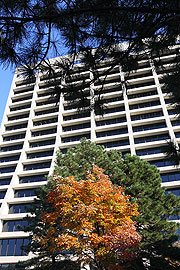 |
|
This photo of Wilson Hall from the parking lot just north of the Linac enclosure, taken by Alex Waller, AD, offers a different perspective of fall at Fermilab. Photo: Alex Waller, AD |
|
Fermilab prairie seed harvest
At 10 a.m. on Saturday, Oct. 29, join the Fermilab Natural Areas (FNA) crew for the annual Fermilab Prairie Seed Harvest.
All ages and abilities are welcome to spend a day in the autumn prairie at Fermilab. Participants help us collect the bulk of our seed for the year. This year the harvest will take place in the Main Ring prairie, where parking is available. Please watch for directional signs as you enter the Fermilab site. A hot dog lunch will be provided.
Fermilab staff and volunteers will show you what and where to collect. Please bring your own gloves, clippers and containers such as paper bags (especially with handles) or buckets, if you have them. Weather-appropriate outdoor clothing is highly recommended.
This social event allows participants to enjoy the outdoors and learn a bit about the prairie. Please let FNA know if you are bringing a large group so we can be sure to accommodate everyone. In case of bad weather, call the Fermilab switchboard for more information at (630) 840-3000.
|
Shangri-La Chinese Acrobats
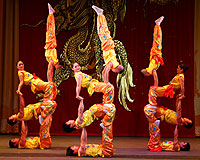 |
|
Photo: Tom Meinhold Photography
|
At 7 p.m. on Saturday, Oct. 29, Fermilab Art Series will present the Shangri-La Chinese Acrobats in Ramsey Auditorium. Tickets are $28 for adults and $14 for minors.
For more information, please visit the Fermilab Art Series website.
|
Faster-than-light neutrino result to get extra checks
From New Scientist, Oct. 25, 2011
Neutrinos may move faster than light, but double-checking the results is decidedly slower, as the team prepares to submit a paper for publication.
Last month the OPERA collaboration at Gran Sasso, Italy, announced that neutrinos had arrived from CERN, 730 kilometres away in Switzerland, 60 nanoseconds faster than light speed. The controversial claim triggered a flood of criticism, support and speculation from the rest of the physics world.
Some OPERA team members have reservations too. Fifteen of the 160-strong collaboration did not sign their names to the preprint of the paper because they considered the results too preliminary.
Read more
|
|
The quarks that miss
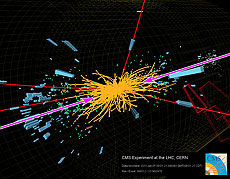 |
|
The magenta arrows indicate the paths of the protons before collision, the four red lines are particles resulting from direct quark or gluon annihilation, while much of the yellow and blue are fragments of the protons that missed each other.
|
In his freshman physics lectures, Richard Feynman compared the principle of energy conservation to a child playing with blocks. At the end of the day, the child seemed to have fewer blocks than he was given at the beginning of the day―until his mother looked hard enough and found them hidden under the bed. Similarly, we believe that energy cannot be created or destroyed because whenever some energy appears to be missing, we eventually find it hiding in another form.
When the LHC collides protons, the resulting energy forms new particles. The new particles are usually known types, like W and Z bosons, though new types, such as Higgs bosons, would also be produced if they exist. However, only a fraction of the collision energy produces particles in this way. It even varies from one event to another--many collisions convert only a tenth or a hundredth of the impact energy into new particles, while some rare events convert nearly all of it.
Where is the energy hiding? The key is that protons are composed of more fundamental particles--quarks and gluons-- that collide. When two protons pass through each other, usually only one quark or gluon from each actually annihilate to make new particles. The rest of the fragments are deflected and carry most of the energy as a spray of particles close to the beamline.
In every collision event, the shrapnel from these near-misses overlaps the products of the direct impact. This complicates the data, but physicists are able to untangle them. The near-misses are interesting in their own right: a recent CMS paper presents a study of the number and energy of these particles. A thorough understanding of the quarks that miss improves the accuracy of identifying the quarks that hit, as well as the exact points in space where each collision took place. It also yields deeper insight into the inner structure of protons, which are perhaps the most familiar and yet most complex particles in physics.
—Jim Pivarski
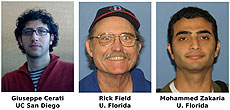 |
| The U.S. physicists pictured above contributed to this analysis, which was an international effort.
|
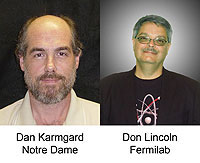 |
|
The CMS collaboration has long been committed to share its exciting findings with the public. After years of service, Dan Karmgard has stepped down as the US CMS Education and Outreach Coordinator. He has been replaced by Don Lincoln.
|
|
|